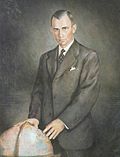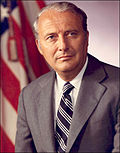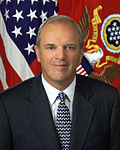United States Secretary of the Army
Statutory office and the head of the U.S. Department of the Army From Wikipedia, the free encyclopedia
The secretary of the Army (SA or SECARMY) is a senior civilian official within the United States Department of Defense, with statutory responsibility for all matters relating to the United States Army: manpower, personnel, reserve affairs, installations, environmental issues, weapons systems and equipment acquisition, communications and financial management.
| United States Secretary of the Army | |
|---|---|
 | |
 Flag of the secretary[1] | |
| United States Department of the Army | |
| Style | Mr. Secretary |
| Reports to | United States Secretary of Defense |
| Appointer | President of the United States with Senate advice and consent |
| Term length | No fixed term |
| Precursor | Secretary of War |
| Formation | September 18, 1947 |
| First holder | Kenneth Claiborne Royall |
| Succession | 2nd in SecDef succession |
| Deputy | Under Secretary of the Army Chief of Staff of the Army |
| Salary | Executive Schedule, Level II |
| Website | Official website |
The secretary of the Army is nominated by the president of the United States and confirmed by the United States Senate. The secretary is a non-Cabinet-level official, subordinate to the secretary of defense.[2] This position was created on September 18, 1947, replacing the secretary of war, when the Department of War was split into the Department of the Army and Department of the Air Force.[3]
On February 25, 2025, Daniel Driscoll was confirmed as the secretary of the Army, and was sworn in to office later that day.
Roles and responsibilities
The Army senior leadership consists of two civilians; the secretary of the Army and the under secretary of the Army—and two military officers of four-star rank—the chief of staff of the United States Army and the vice chief of staff.
The secretary of the Army (10 U.S.C. § 7013) is in effect the chief executive officer of the Department of the Army, and the chief of staff of the Army works directly for the secretary. The secretary presents and justifies Army policies, plans, programs, and budgets to the secretary of defense, other executive branch officials, and to the congressional Defense Committees. The secretary also communicates Army policies, plans, programs, capabilities, and accomplishments to the public. As necessary, the secretary convenes meetings with the senior leadership of the Army to debate issues, provide direction, and seek advice. The secretary is a member of the Defense Acquisition Board.
The secretary of the Army has several responsibilities under the Uniform Code of Military Justice, including the authority to convene general courts-martial.[4]
Office of the Secretary of the Army
Summarize
Perspective
The Office of the Secretary of the Army is composed of the under secretary of the Army, the assistant secretaries of the Army, the administrative assistant to the secretary, the general counsel of the Department of the Army, the inspector general of the Army, the chief of legislation, and the Army Reserve Forces Policy Committee. Other offices may be established by law or by the secretary of the Army. No more than 1,900 Army officers on the active-duty list may be assigned or detailed to permanent duty in the Office of the Secretary of the Army and on the Army staff.[5]
- Under Secretary of the Army
- Assistant Secretary of the Army (Acquisition, Logistics, and Technology)
- Assistant Secretary of the Army (Civil Works)
- Assistant Secretary of the Army (Financial Management and Comptroller)
- Assistant Secretary of the Army (Installations, Energy and Environment)
- Assistant Secretary of the Army (Manpower and Reserve Affairs)
- General Counsel of the Army
- Administrative Assistant to the Secretary of the Army
- Inspector General of the Army
Each civilian has a military counterpart, as shown in the diagram below. Thus, for example, the Army G-1 has a defined responsibility to the Assistant Secretary of the Army (Manpower and Reserve Affairs), the ASA (M&RA).

Chronological list of secretaries of the Army
Summarize
Perspective
Kenneth Claiborne Royall, the last secretary of war, became the first secretary of the Army when the National Defense Act of 1947 took effect. Gordon Gray was the last Army secretary to hold the Cabinet status, which was henceforth assigned to the secretary of defense.[3][6]
Prior military service is not a requirement, but several have served in the United States armed forces. Secretary Stone (1989-1993) is the only holder to serve in the military outside of the United States.
| No. | Image | Name | Start | End | President(s) | |
|---|---|---|---|---|---|---|
| 1 |  |
Kenneth Claiborne Royall | September 18, 1947 | April 27, 1949 | Harry S. Truman (1945–1953) | |
| 2 |  |
Gordon Gray[7] | April 28, 1949 | April 12, 1950 | ||
| 3 |  |
Frank Pace | April 12, 1950 | January 20, 1953 | ||
| – |  |
Earl D. Johnson Acting[7] |
January 20, 1953 | February 4, 1953 | Dwight D. Eisenhower (1953–1961) | |
| 4 |  |
Robert T. Stevens | February 4, 1953 | July 21, 1955 | ||
| 5 |  |
Wilber M. Brucker | July 21, 1955 | January 19, 1961 | ||
| 6 |  |
Elvis Jacob Stahr Jr. | January 24, 1961 | June 30, 1962 | John F. Kennedy (1961–1963) | |
| 7 |  |
Cyrus Vance | July 5, 1962 | January 21, 1964 | ||
| Lyndon B. Johnson (1963–1969) | ||||||
| 8 |  |
Stephen Ailes | January 28, 1964 | July 1, 1965 | ||
| 9 |  |
Stanley Resor | July 2, 1965 | June 30, 1971 | ||
| Richard Nixon (1969–1974) | ||||||
| 10 |  |
Robert Froehlke | July 1, 1971 | May 14, 1973 | ||
| 11 |  |
Bo Callaway | May 15, 1973 | July 3, 1975 | ||
| Gerald Ford (1974–1977) | ||||||
| – |  |
Norman R. Augustine Acting[7] |
July 3, 1975 | August 5, 1975 | ||
| 12 |  |
Martin Hoffmann | August 5, 1975 | January 20, 1977 | ||
| 13 |  |
Clifford Alexander Jr. | February 14, 1977 | January 20, 1981 | Jimmy Carter (1977–1981) | |
| – |  |
Percy A. Pierre Acting[7] |
January 21, 1981 | January 29, 1981 | Ronald Reagan (1981–1989) | |
| 14 |  |
John Marsh | January 30, 1981 | August 14, 1989 | ||
| George H. W. Bush (1989–1993) | ||||||
| 15 |  |
Michael P. W. Stone | August 14, 1989 | January 20, 1993 | ||
| – |  |
John W. Shannon Acting[8][9] |
January 20, 1993 | August 26, 1993 | Bill Clinton (1993–2001) | |
| – |  |
Gordon R. Sullivan Acting[10][11] |
August 28, 1993 | November 21, 1993 | ||
| 16 |  |
Togo D. West Jr. | November 22, 1993 | May 4, 1997 | ||
| – |  |
Robert M. Walker Acting[7] |
December 2, 1997 | July 1, 1998 | ||
| 17 |  |
Louis Caldera | July 2, 1998 | January 20, 2001 | ||
| – |  |
Gregory R. Dahlberg Acting |
January 20, 2001 | March 4, 2001 | George W. Bush (2001–2009) | |
| – |  |
Joseph W. Westphal Acting[7] |
March 5, 2001 | May 31, 2001 | ||
| 18 |  |
Thomas E. White | May 31, 2001 | May 9, 2003 | ||
| – |  |
Les Brownlee Acting |
May 10, 2003 | November 18, 2004 | ||
| 19 |  |
Francis J. Harvey | November 19, 2004 | March 9, 2007 | ||
| 20 |  |
Pete Geren | March 9, 2007 | September 21, 2009 | ||
| Barack Obama (2009–2017) | ||||||
| 21 |  |
John M. McHugh | September 21, 2009 | November 1, 2015 | ||
| – |  |
Eric Fanning Acting |
November 3, 2015 | January 11, 2016 | ||
| – |  |
Patrick Murphy Acting |
January 11, 2016 | May 17, 2016 | ||
| 22 |  |
Eric Fanning | May 17, 2016 | January 20, 2017 | ||
| – |  |
Robert Speer Acting |
January 20, 2017 | August 2, 2017 | Donald Trump (2017–2021) | |
| – |  |
Ryan D. McCarthy Acting |
August 2, 2017 | November 20, 2017 | ||
| 23 |  |
Mark Esper | November 20, 2017 On leave: June 24, 2019 – July 15, 2019[12] |
July 23, 2019 | ||
| – |  |
Ryan D. McCarthy Acting[12] |
June 24, 2019 | July 15, 2019 | ||
| 24 |  |
Ryan D. McCarthy | July 23, 2019 | September 30, 2019 | ||
| September 30, 2019 | January 20, 2021 | |||||
| – |  |
John E. Whitley Acting |
January 20, 2021 | May 28, 2021 | Joe Biden (2021–2025) | |
| 25 |  |
Christine Wormuth | May 28, 2021 | January 20, 2025 | ||
| – |  |
Mark Averill Acting |
January 20, 2025 | February 25, 2025 | Donald Trump (2025–present) | |
| 26 |  |
Daniel P. Driscoll | February 25, 2025 | Incumbent | ||
References
External links
Wikiwand - on
Seamless Wikipedia browsing. On steroids.

